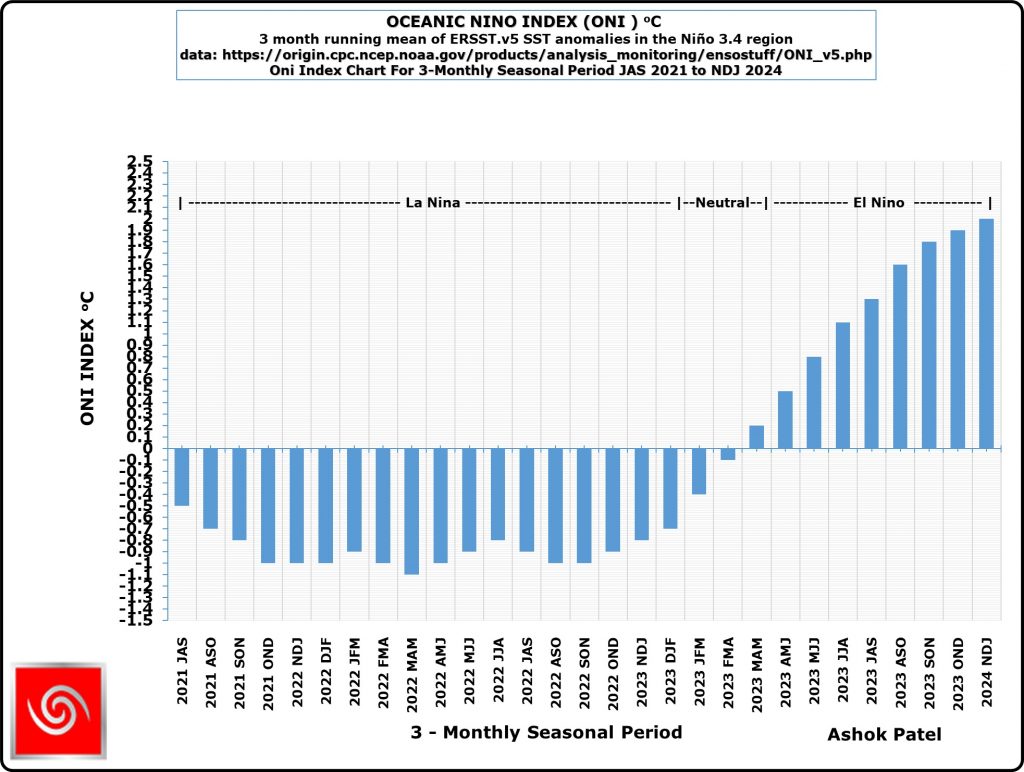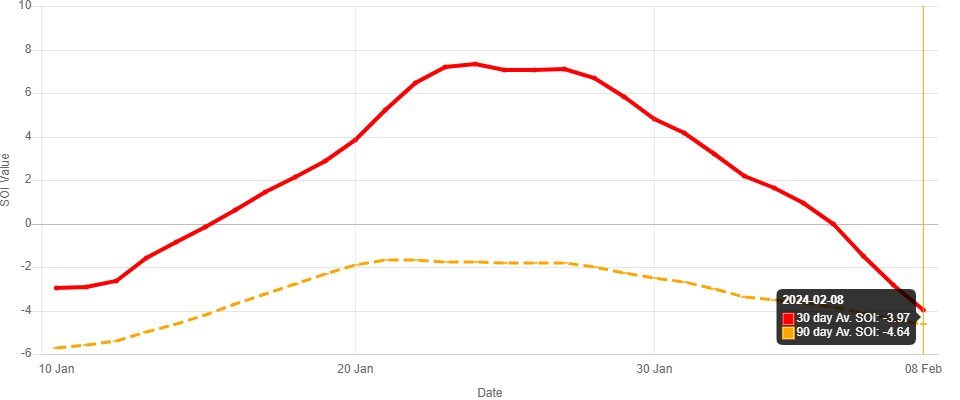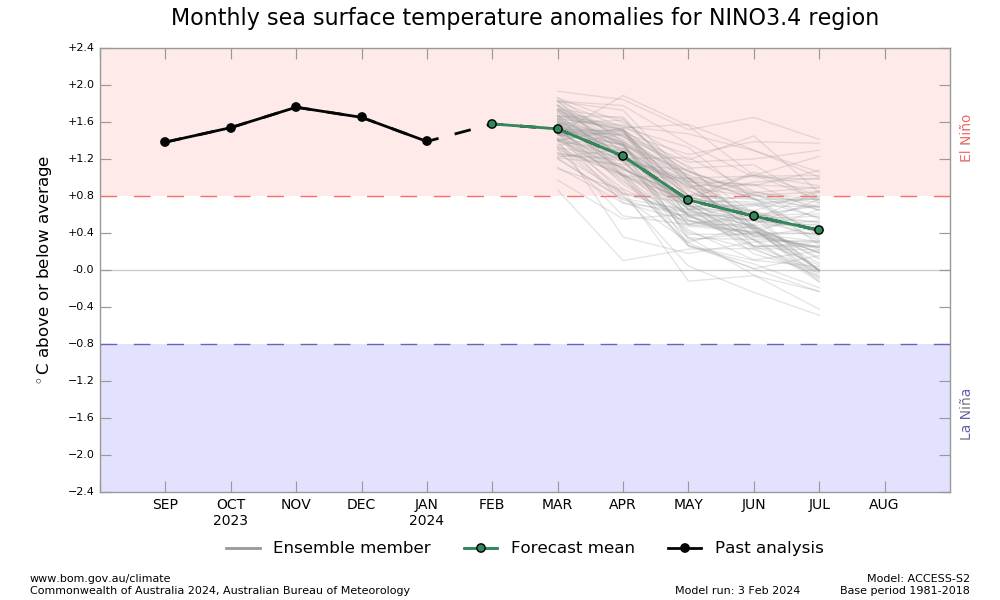Strong El Nino Conditions Prevails At The End Of January 2024 – However This El Nino Not Expected To Be As Strong As 1982-83 Or 1997-98 Or 2015-16 El Nino
Enso Status on 10th February 2024
Ashok Patel’s Analysis & Commentary :
The classification of El Niño events, including the strength labels, is somewhat subjective and can vary among meteorological and climate agencies. There isn’t a strict rule defining the specific number of consecutive Oceanic Niño Index (ONI) values that must be 2.0°C or above to categorize an El Niño event as “Super Strong.”
In general, a strong El Niño event is often characterized by ONI values reaching or exceeding +2.0°C. A Super Strong El Niño would typically involve sustained ONI value of +2.0°C or more. Hence for ease of understanding and comparing the strength of various Strong El Nino events, I propose to define an El Nino as a Super Strong event if three consecutive ONI index is +2.0°C or more.
A brief history of the past El Nino events with the number of consecutive ONI +2.0°C or above:
In the year 1965 the highest ONI index during that El Nino were SON +2.0°C, OND +2.0°C
In the year 1972-73 the highest ONI index during that El Nino were OND +2.1°C NDJ +2.1°C DJF
In the year 1982-83 the highest ONI index during that El Nino were SON +2.0°C, OND +2.2°C NDJ +2.2°C DJF +2.2°C
In the year 1997-98 the highest ONI index during that El Nino were ASO +2.1°C SON +2.3°C, OND +2.4°C NDJ +2.4°C DJF +2.2°C
In the year 2015-16 the highest ONI index during that El Nino were ASO +2.2°C SON +2.4°C, OND +2.6°C NDJ +2.6°C DJF +2.5°C JFM +2.1°C
ONI Data has been obtained from CPC – NWS – NOAA available here
There have been three Super Strong El Nino events from 1950 onwards till date. The first such event was 1982-83 Super Strong El Nino with 4 consecutive ONI +2.0°C or above with highest ONI of +2.2°C twice. The second Super Strong El Nino event was 1997-98 with five consecutive ONI +2.0°C or above with highest ONI of +2.4°C twice. The third Super Strong El Nino event was 2015-16 with six consecutive ONI +2.0°C or above with highest ONI of +2.6°C twice. The current forecast and analysis does not support the 2023-24 El Nino to become a Super Strong El Nino.
Indian Monsoon & Enso relationship for India:
Based on earlier more than 100 years weather Data for Indian Summer Monsoon, The Average Rainfall in an El Nino years is 94% of LPA while in La Nina Years it has been 106 % of LPA for the whole country. Monsoon Rainfall over India had been +94.4% of LPA at the end of 30th September 2023. El Nino or La Nina may affect the Monsoon differently for different Regions of India and warrants research for concrete co-relations for each region of India if any. Performance of Southwest Monsoon 2023 over the entire Country was much better than expected.
How ONI is determined:
The ONI is based on SST departures from average in the Niño 3.4 region, and is a principal measure for monitoring, assessing, and predicting ENSO. Defined as the three-month running-mean SST departures in the Niño 3.4 region. Departures are based on a set of further improved homogeneous historical SST analyses (Extended Reconstructed SST – ERSST.v5).
NOAA Operational Definitions for El Niño and La Niña, El Niño: characterized by a positive ONI greater than or equal to +0.5ºC. La Niña: characterized by a negative ONI less than or equal to -0.5ºC. By historical standards, to be classified as a full-fledged El Niño or La Niña episode, these thresholds must be exceeded for a period of at least 5 consecutive overlapping 3-month seasons.
CPC considers El Niño or La Niña conditions to occur when the monthly Niño3.4 OISST departures meet or exceed +/- 0.5ºC along with consistent atmospheric features. These anomalies must also be forecast to persist for 3 consecutive months.
The Climate Prediction Center (CPC) is a United States Federal Agency that is one of the NECP, which are a part of the NOAA
Latest Oceanic Nino Index Graph Shows
El Nino Conditions Are Prevailing At The End Of January 2024
The Table below shows the monthly SST of Nino3.4 Region and the Climate adjusted normal SST and SST anomaly from July 2021. Climate Base 1991-2020. ERSST.v5
Period Nino3.4 ClimAdjust YR MON Temp.ºC Temp.ºC ANOM ºC 2021 7 26.90 27.29 -0.39 2021 8 26.32 26.86 -0.53 2021 9 26.16 26.72 -0.55 2021 10 25.78 26.72 -0.94 2021 11 25.76 26.70 -0.94 2021 12 25.54 26.60 -1.06 2022 1 25.61 26.55 -0.95 2022 2 25.88 26.76 -0.89 2022 3 26.33 27.29 -0.97 2022 4 26.72 27.83 -1.11 2022 5 26.83 27.94 -1.11 2022 6 26.98 27.73 -0.75 2022 7 26.60 27.29 -0.70 2022 8 25.88 26.86 -0.97 2022 9 25.65 26.72 -1.07 2022 10 25.73 26.72 -0.99 2022 11 25.80 26.70 -0.90 2022 12 25.75 26.60 -0.86 2023 1 25.84 26.55 -0.71 2023 2 26.30 26.76 -0.46 2023 3 27.19 27.29 -0.11 2023 4 27.96 27.83 0.14 2023 5 28.40 27.94 0.46 2023 6 28.57 27.73 0.84 2023 7 28.31 27.29 1.02 2023 8 28.21 26.86 1.35 2023 9 28.32 26.72 1.60 2023 10 28.44 26.72 1.72 2023 11 28.72 26.70 2.02 2023 12 28.63 26.60 2.02 2024 1 28.42 26.55 1.87
Indications and analysis of various International Weather/Climate agencies monitoring ENSO conditions is depicted hereunder:
Summary by: Climate Prediction Center / NCEP Dated 4th February 2024
ENSO Alert System Status: El Niño Advisory
El Niño conditions are observed.*
Equatorial sea surface temperatures (SSTs) are above average across the central and eastern Pacific Ocean.
The tropical Pacific atmospheric anomalies are consistent with El Niño.
El Niño is expected to continue for the next several seasons, with ENSO-neutral favored during April-June 2024 (73% chance).*
Note: These statements are updated once a month (2nd Thursday of each month) in association with the ENSO Diagnostics Discussion, which can be found by clicking here.
Recent (preliminary) Southern Oscillation Index values as per The Long Paddock – Queensland Government.
30 Days average SOI was 3.96 at the end of January 2024 and was -3.97 on 8th February 2024 as per The Long Paddock – Queensland Government and 90 Days average SOI was -4.64 on 8th February 2024. During January 2024 the SOI had become +3.96 and is -3.97 currently.
Southern Oscillation Index
As per BOM, Australia
The 30-day Southern Oscillation Index (SOI) for the period ending 31 January 2024 was 3.7 and was 0.7 on 4th February 2024 and is moving towards negative direction once again..
Sustained negative values of the SOI below −7 typically indicate El Niño while sustained positive values above +7 typically indicate La Niña. Values between +7 and −7 generally indicate neutral conditions.
As per BOM – Australia 6th February 2024
El Niño has peaked and is declining
ENSO Outlook
Climate model outlooks suggest El Niño has peaked and is declining, indicating a return to neutral in the southern hemisphere autumn 2024. The ENSO Outlook will remain at El Niño status until this event decays, or signs of a possible La Niña appear.



